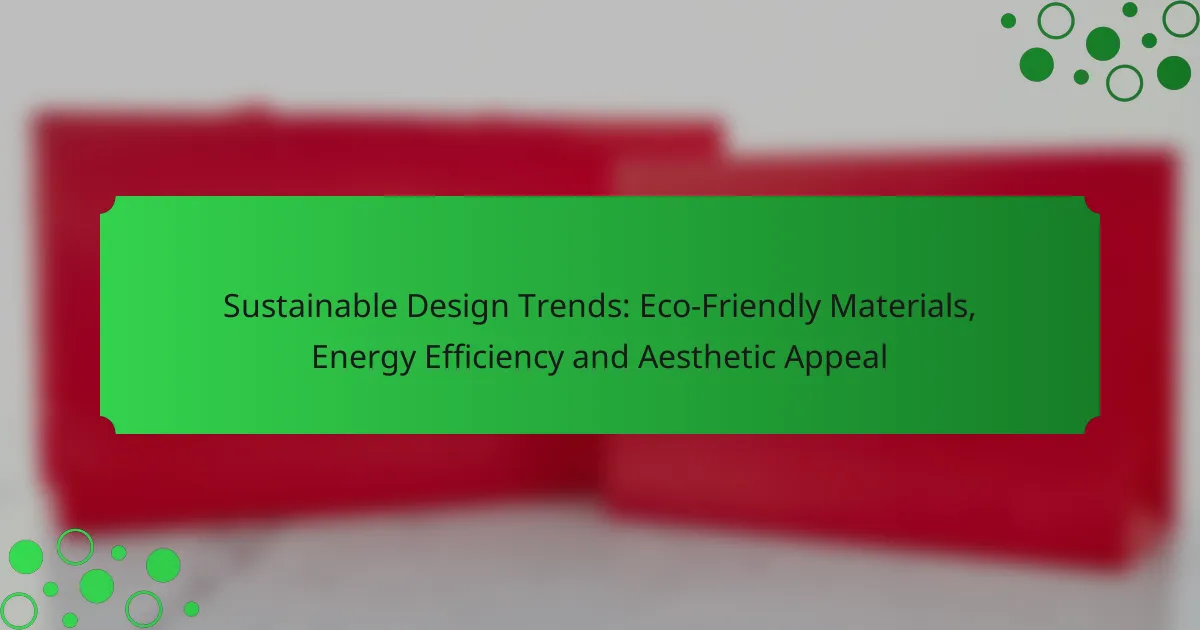As sustainable design trends gain momentum in urban environments, the focus is on integrating eco-friendly materials, enhancing energy efficiency, and ensuring aesthetic appeal. This approach not only reflects a commitment to environmental responsibility but also creates functional and visually engaging spaces that resonate with modern sensibilities.
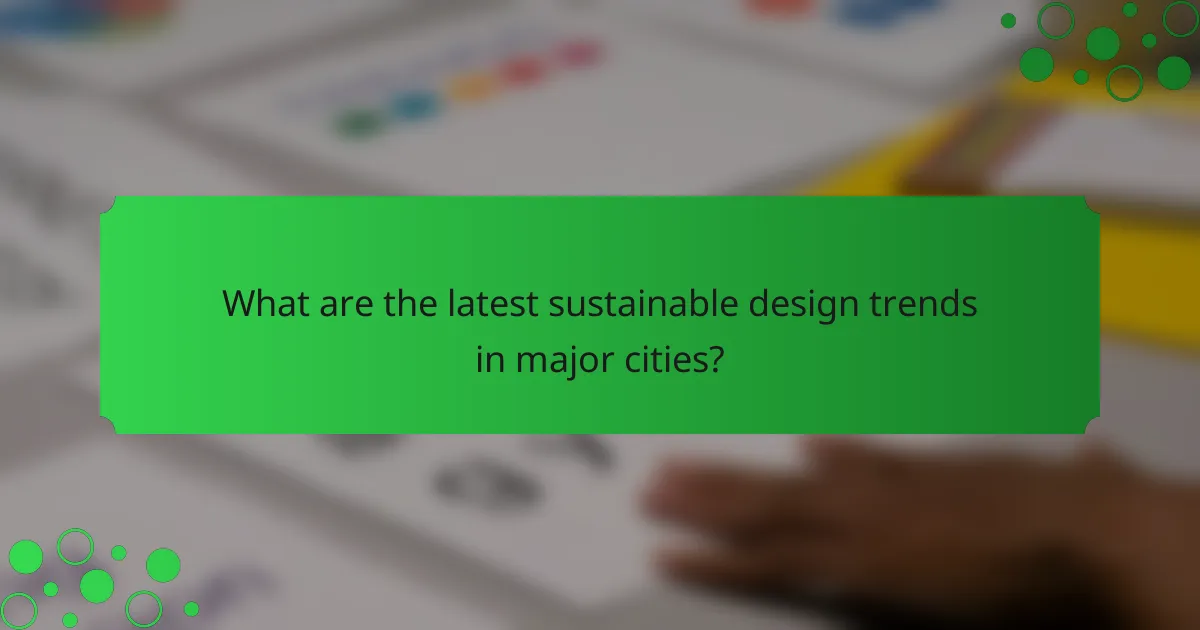
What are the latest sustainable design trends in major cities?
The latest sustainable design trends in major cities focus on integrating eco-friendly materials, enhancing energy efficiency, and maintaining aesthetic appeal. These trends reflect a growing commitment to environmental responsibility while creating functional and visually pleasing spaces.
Biophilic design integration
Biophilic design emphasizes the connection between people and nature, incorporating natural elements into urban environments. This can include features like green walls, indoor plants, and natural light, which enhance well-being and productivity. Cities are increasingly adopting biophilic principles to create healthier living and working spaces.
To implement biophilic design, consider using materials that mimic natural textures and colors, and ensure that outdoor views are maximized. This approach not only improves aesthetics but also contributes to mental health and reduces stress levels.
Use of recycled materials
Using recycled materials is a key trend in sustainable design, reducing waste and conserving resources. Commonly recycled materials include reclaimed wood, recycled metal, and repurposed glass, which can be used in construction and interior design. This practice not only minimizes environmental impact but also adds unique character to spaces.
When selecting recycled materials, look for certifications that verify their sustainability, such as the Forest Stewardship Council (FSC) for wood products. This ensures that the materials are sourced responsibly and contribute positively to the environment.
Smart energy-efficient technologies
Smart energy-efficient technologies are transforming how buildings consume energy. Innovations such as smart thermostats, energy-efficient lighting, and automated systems help reduce energy usage and lower utility costs. These technologies are becoming standard in new constructions and renovations in urban areas.
To enhance energy efficiency, consider integrating solar panels, energy storage systems, and high-performance insulation. These investments can lead to significant long-term savings and may qualify for local incentives or rebates, making them financially attractive.
Minimalist aesthetic appeal
The minimalist aesthetic focuses on simplicity and functionality, often featuring clean lines and uncluttered spaces. This design trend promotes the idea that less is more, encouraging the use of fewer materials and a more thoughtful approach to space. Minimalism aligns well with sustainability by reducing waste and emphasizing quality over quantity.
Incorporating minimalist design can involve choosing versatile furniture, neutral color palettes, and multifunctional spaces. This not only creates a visually appealing environment but also fosters a sense of calm and order, which is increasingly valued in urban living.
Adaptive reuse of buildings
Adaptive reuse involves repurposing existing buildings for new uses, preserving historical architecture while minimizing the need for new construction. This trend is gaining traction in cities as it reduces waste and conserves resources, making it a sustainable option for urban development.
When considering adaptive reuse, assess the structural integrity of the building and its potential for new functions. This approach can breathe new life into old spaces, creating unique environments that honor the past while serving modern needs.
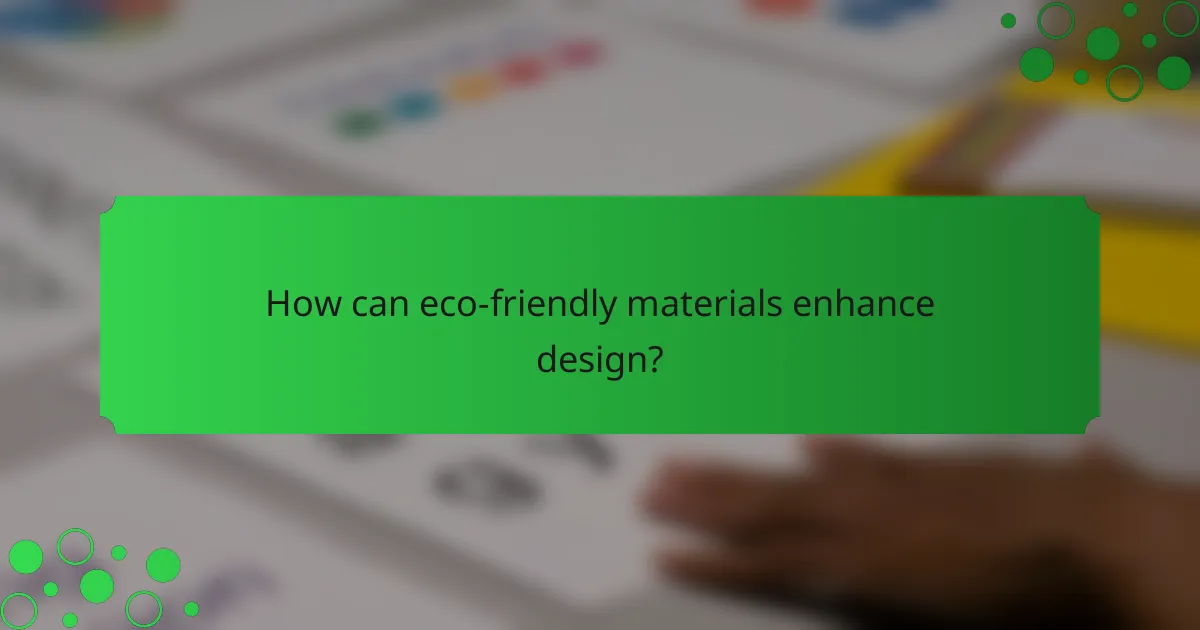
How can eco-friendly materials enhance design?
Eco-friendly materials can significantly enhance design by promoting sustainability while maintaining aesthetic appeal. These materials often reduce environmental impact and can offer unique textures and colors that elevate a space.
Natural fibers like hemp and bamboo
Natural fibers such as hemp and bamboo are popular choices in sustainable design due to their renewability and biodegradability. Hemp grows quickly and requires minimal pesticides, making it an eco-friendly option for textiles and insulation.
Bamboo, known for its strength and versatility, can be used in flooring, furniture, and decorative elements. Its rapid growth cycle allows for sustainable harvesting, providing a responsible alternative to traditional hardwoods.
Recycled metals and plastics
Recycled metals and plastics contribute to sustainable design by reducing waste and conserving resources. Using recycled aluminum or steel can lower energy consumption during production, while recycled plastics can be transformed into stylish furniture or decorative items.
When selecting recycled materials, look for certifications that indicate a high percentage of post-consumer content. This ensures that the materials have been responsibly sourced and processed, further enhancing their eco-friendly credentials.
Low-VOC paints and finishes
Low-VOC (volatile organic compounds) paints and finishes are essential for creating healthier indoor environments. These products emit fewer harmful chemicals, improving air quality and reducing health risks associated with traditional paints.
When choosing low-VOC options, check for labels that specify compliance with environmental standards, such as Green Seal or GREENGUARD. This can help ensure that you are selecting products that are both effective and environmentally responsible.

What are the benefits of energy efficiency in design?
Energy efficiency in design reduces energy consumption, leading to lower utility costs and a smaller environmental footprint. By incorporating energy-efficient practices, buildings can achieve significant savings while enhancing comfort and sustainability.
Reduced utility costs
Implementing energy-efficient designs can lead to substantial reductions in utility bills. For instance, using high-efficiency appliances and LED lighting can cut energy usage by 20-30% compared to standard options. Additionally, proper insulation and energy-efficient windows can minimize heating and cooling costs, further lowering monthly expenses.
Homeowners and businesses should consider conducting an energy audit to identify areas for improvement. Simple upgrades, such as programmable thermostats or energy-efficient HVAC systems, can yield quick returns on investment.
Improved indoor air quality
Energy-efficient designs often incorporate better ventilation and air filtration systems, which enhance indoor air quality. By using materials that emit fewer volatile organic compounds (VOCs) and ensuring proper airflow, occupants can experience a healthier environment. This is particularly beneficial in urban areas where outdoor air quality may be compromised.
Choosing low-VOC paints, finishes, and materials can significantly reduce indoor pollutants. Regular maintenance of HVAC systems also plays a crucial role in maintaining clean air within the space.
Increased property value
Properties designed with energy efficiency in mind often see an increase in market value. Buyers are increasingly looking for homes that offer lower operating costs and sustainable features. Energy-efficient certifications, such as LEED or Energy Star, can make a property more attractive to potential buyers.
Investing in energy-efficient upgrades not only enhances comfort but can also lead to higher resale values. Features like solar panels or energy-efficient windows can be strong selling points in competitive real estate markets.
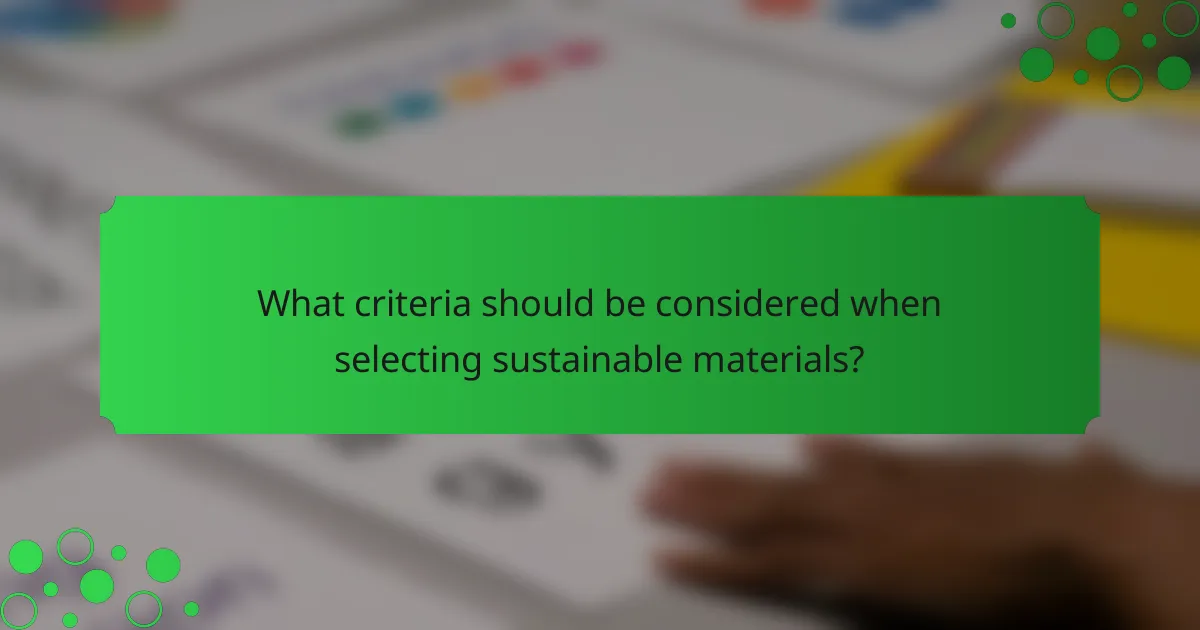
What criteria should be considered when selecting sustainable materials?
When selecting sustainable materials, consider their environmental impact, durability, and the availability of local options. Prioritizing these criteria helps ensure that your design is both eco-friendly and practical.
Durability and lifecycle assessment
Durability is crucial for sustainable materials as it directly affects their lifecycle and overall environmental impact. Materials that last longer reduce the need for replacements, minimizing waste and resource consumption. Conducting a lifecycle assessment can help evaluate the environmental effects of a material from extraction to disposal.
Look for materials that have a proven track record of longevity and require minimal maintenance. For example, bamboo and reclaimed wood are known for their durability and aesthetic appeal, making them excellent choices for sustainable design.
Local sourcing and availability
Local sourcing of materials reduces transportation emissions and supports the local economy. When materials are sourced nearby, the carbon footprint associated with shipping is significantly lower, contributing to overall sustainability. Check for regional suppliers to find eco-friendly options that are readily available.
Consider materials that are abundant in your area, such as locally harvested stone or timber. This not only ensures availability but also often results in lower costs, as transportation expenses are minimized.
Certifications like LEED and BREEAM
Certifications such as LEED (Leadership in Energy and Environmental Design) and BREEAM (Building Research Establishment Environmental Assessment Method) provide a framework for evaluating the sustainability of materials. These certifications assess various factors, including energy efficiency, water usage, and material sourcing, helping you make informed choices.
When selecting materials, look for those that have been certified by these programs, as they meet stringent sustainability criteria. This can enhance the credibility of your project and may even qualify for incentives or funding in some regions.
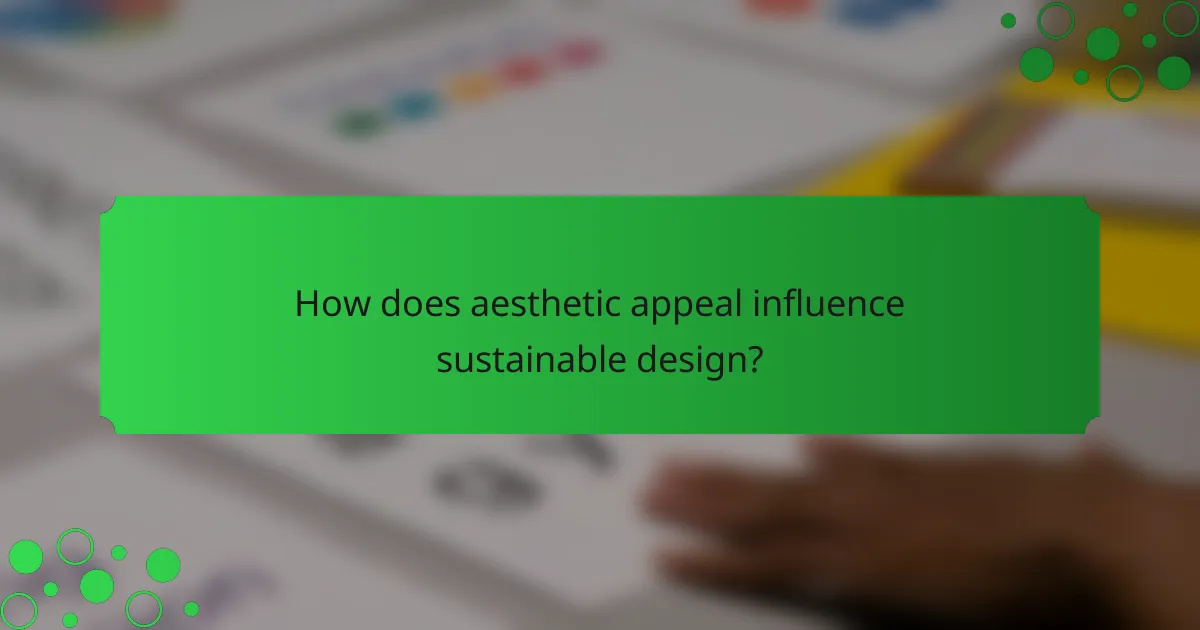
How does aesthetic appeal influence sustainable design?
Aesthetic appeal significantly impacts sustainable design by enhancing the visual attractiveness of eco-friendly materials and energy-efficient solutions. When designs are visually appealing, they encourage broader acceptance and integration of sustainable practices in everyday life.
Visual harmony with nature
Creating visual harmony with nature involves incorporating elements that reflect the surrounding environment. This can be achieved through the use of natural materials like wood, stone, and plant life, which blend seamlessly into their settings. Designs that mimic natural forms and colors often evoke a sense of tranquility and connection to the outdoors.
For example, using earthy tones and organic shapes can make a building feel more integrated into its landscape. This approach not only enhances aesthetic appeal but also promotes a sense of well-being among occupants.
Innovative use of color and texture
Innovative use of color and texture can elevate sustainable design by making it visually striking while remaining eco-conscious. Bright, vibrant colors can draw attention to energy-efficient features, while varied textures can add depth and interest to surfaces made from sustainable materials.
Consider using recycled materials with unique textures or finishes to create focal points in a space. This not only showcases sustainability but also adds character and personality to the design.
Timeless design principles
Timeless design principles, such as balance, proportion, and symmetry, play a crucial role in sustainable design. These principles ensure that eco-friendly structures are not only functional but also aesthetically pleasing over time. A well-proportioned space can enhance usability while maintaining visual appeal.
Incorporating classic design elements, such as large windows for natural light or open floor plans, can create enduring spaces that remain attractive and efficient. This approach helps avoid trends that may quickly become outdated, ensuring the design remains relevant and appreciated for years to come.
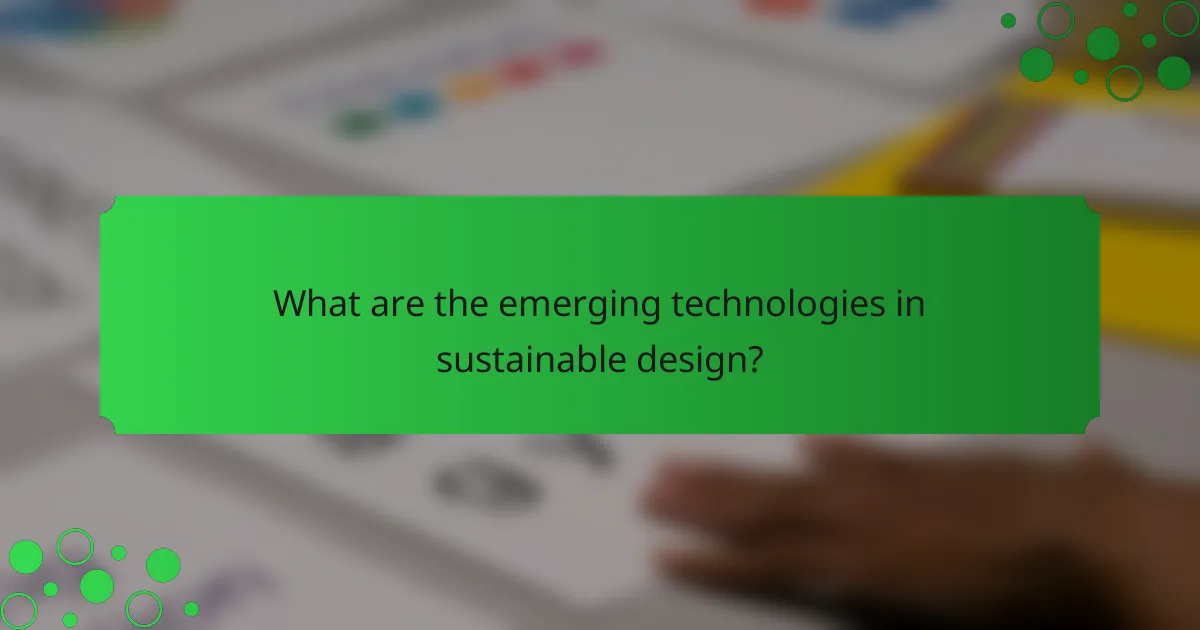
What are the emerging technologies in sustainable design?
Emerging technologies in sustainable design focus on minimizing environmental impact while enhancing functionality and aesthetics. Innovations such as advanced materials, energy-efficient systems, and digital fabrication techniques are reshaping how we approach eco-friendly design.
3D printing with sustainable materials
3D printing with sustainable materials involves using biodegradable or recycled substances to create products and structures. This technology reduces waste and allows for more efficient use of resources, making it a popular choice in sustainable design.
Common materials for 3D printing include PLA (polylactic acid), which is derived from corn starch, and recycled plastics. These materials can significantly lower the carbon footprint compared to traditional manufacturing methods. For example, using recycled plastics can reduce energy consumption by up to 60% compared to virgin materials.
When considering 3D printing for sustainable design, it’s essential to evaluate the material’s properties, such as strength and durability, to ensure they meet project requirements. Additionally, be mindful of the printer’s energy consumption and seek models that are energy-efficient to further enhance sustainability.
